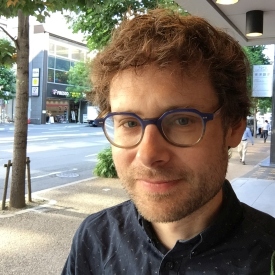
I’ve just arrived in Raleigh for the Local and Mobile conference, which seeks to link mobilities, mobile communication, and locative media…
I’m presenting with George Villanueva about our ParTour project and situated engagement this Sunday at 9am (ouch!). Here’s the abstract:
ParTour: Leveraging the Dual Mobilities of Cellphones and Bicycles for Urban Change
Bar, F., Gonzalez, C., Khera, O., Stokes, B., Villanueva, G. (alphabetical)
Can basic cell phones and bicycles help re-imagine Los Angeles? In this paper, we consider a participatory storytelling and mapping platform called ParTour, a pilot project advocating urban social change. Over 70 residents were dispatched on bicycle quests to gather pieces of a collective story. We analyze this production as part of a place-based storytelling network. Simultaneously, we consider how the ParTour design hacks into urban culture, resonating with the ascendant bicycle movement in Los Angeles and its Do-It-Yourself (DIY) practices for engaging public space.
This paper uses the ParTour case study to propose a theoretical alignment of two mobilities: DIY bicycle culture and the locative media of phone-based storytelling. Using the methods of design-research, we argue that these dual mobilities can be powerfully aligned in the context of public events, allowing local participants to appropriate their urban surroundings. Our analysis has implications for theoretical alignment between Communication Infrastructure Theory (Ball-Rokeach, et. al 2001), space, the literature on technological appropriation, and cultural studies of bicycles and DIY street culture.
The appropriation of mobile technology and urban space by local residents was a primary design goal for ParTour. By participating, urban users transformed their everyday phones into multi-media tools for geo-locative storytelling, using SMS and MMS rather than smartphone applications. This embodies the re-invention of mobile technology through appropriation described by Bar et al. (2007). The ParTour infrastructure expands upon an open-source mobile platform built with low-wage immigrant workers in Los Angeles to tell stories about their lives and their communities (VozMob Project, 2011).
Inspired by theories of real-world games (Gordon & de Souza e Silva, 2011; Klopfer, 2008), ParTour focuses on activities rather than tools. It creates feedback loops for what we are calling ‘situated engagement‘ in place-based social and civic practices. For example, participants selected quests to structure their activity into goal-based missions, like taking pictures and geo-coding community assets that are valuable enough to be shared with others.
ParTour is deliberately situated within public bicycle rides, especially CicLAvia, the massive Los Angeles event which bans cars from 10+ miles of streets, opening space for bicycles and recreation to advocate for alternative transportation. Mobile social interaction within physical space promotes a re-discovery of familiar surroundings, resulting in appropriation of urban space (Kidder, 2011).
Despite enthusiasm over hyper-local journalism, place-based media is rarely analyzed ecologically. We draw upon Communication Infrastructure Theory (CIT) to situate ParTour within neighborhood-based storytelling networks, which are associated with a range of indicators for healthy neighborhoods. CIT measures the connections between three elements: local residents, community-based organizations, and local media produced for particular geographies or ethnicities. Our analysis particularly considers the role of T.R.U.S.T. South LA, a neighborhood organization advocating for extending the CicLAvia ride further into the distressed neighborhoods of South Los Angeles. We analyze how ParTour shifts the power and storytelling roles for this organization within the storytelling network.
Simultaneously, ParTour’s social practices of participatory storytelling within public events resonates with DIY bicycle culture. As a cultural phenomenon, bike culture is an emerging force in social movements for alternative urban transportation in Los Angeles. We find that the success of ParTour depends on balancing several forces in DIY bike culture, including the fiery desire to retake the streets (Blickstein, 2008), the mastering of available tools (Uckelmann, 2011), and the more conciliatory bike rides, like CicLAvia, sponsored by the local municipality. Here, mobile media amplifies cyclists’ mobility to produce dynamic practices of ‘lived space’ (Lefebvre, 1992).
*** References ***
Ball-Rokeach, S. J., Kim, Y. C., & Matei, S. (2001). Storytelling Neighborhood. Communication Research, 28(4), 392-428.
Bar, F., Pisani, F., & Weber, M. (2007). Mobile technology appropriation in a distant mirror: Baroque infiltration, creolization and cannibalism. Seminario Sobre Desarrollo Económico, Desarrollo Social y Comunicaciones Móviles En América Latina, Buenos Aires, Argentina.
Blickstein, S. G. (2008). Critical mass: Bicycling towards a more sustainable city. Clark University. ProQuest Dissertations and Theses
Gordon, E., & de Souza e Silva, A. (2011). Net Locality: Why Location Matters in a Networked World. Wiley-Blackwell.
Kidder, J. (2009). Appropriating the city: Space, theory, and bike messengers. Theory and Society, 38(3), 307-328.
Klopfer, E. (2008). Augmented learning: Research and design of mobile educational games. The MIT Press.
Lefebvre, H. (1992). The Production of Space. Wiley-Blackwell.
Uckelmann, D. (2011). Enabling the masses to become creative in smart spaces. In Architecting the Internet of things (pp. 37-64) Springer Berlin Heidelberg.
VozMob Project (2011). Mobile voices : Projecting the voices of immigrant workers by appropriating mobile phones for popular communication. In P. M. Napoli, & M. Aslama (Eds.), Communications research in action. New York: Fordham University Press.
